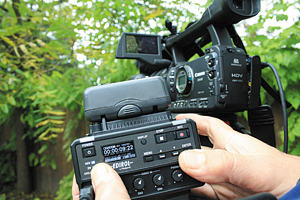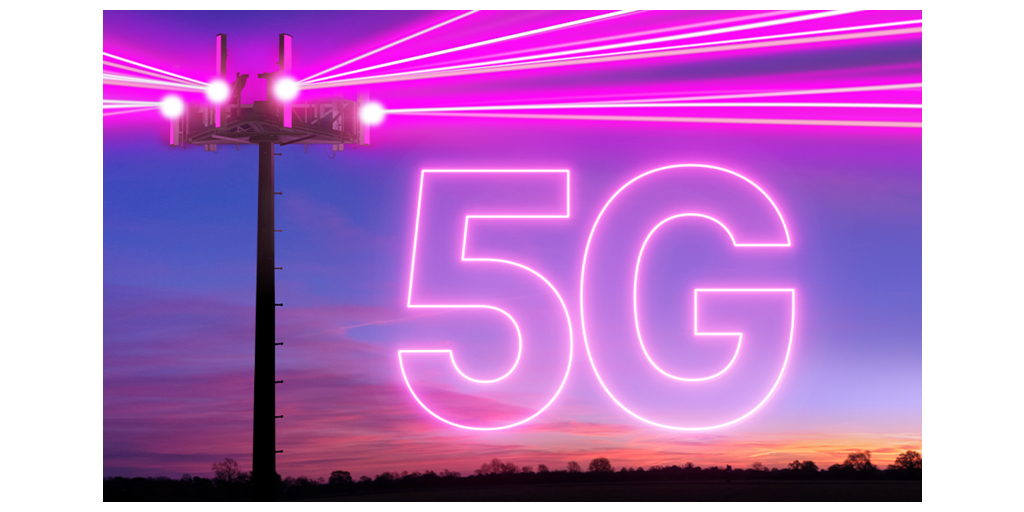Edirol F-1 Video Field Recorder
As we near the sunset of the analog video era, we are seeing more and more tools for recording HD video and compatible audio on media other than videotape. One of the strongest arguments for continuing to use tape despite the many alternatives has been its cost efficiency expressed in minutes of video per dollar cost (or dollars per minute), especially when compared to high-speed Flash media, at least until very recently. Hard-drive-based systems have had the advantage of higher capacity and a lower cost per unit of storage, but without the stability of Flash or even that of tape. Roland takes aim at all of these tradeoffs with the Edirol F-1 Video Field Recorder, which was unveiled at the 2008 NAB Show.
FEATURES

The Edirol F-1 hard drive-based video field recorder. Photo by Cindy Farrington In terms of recording capacity, the F-1 can record nine hours of 1080i HDV or 12 hours of 720p on a single internal 120 GB drive. The drives can be swapped in a matter of seconds, making it feasible to record nearly endlessly with only momentary interruptions every nine to 12 hours. This opens the prospect of round-the-clock recording with periodic, momentary interruption. Moreover, Edirol boasts that the drives are shock-resistant and compare favorably with videotape in that regard.
As with most other tapeless media, video recorded with the F-1 is ready to edit as soon as it's downloaded into an NLE. This underlines the clear advantages of disk-based media for capture where budget is a prime factor. While DV tape is still more cost-effective per minute than most (if not all) tapeless alternatives on a single-use basis given the limited reusability of even HDV mastering tape, this cost advantage quickly erodes when considered on a per-use basis, compared with drive-based alternatives, such as the F-1.
However, the F-1 offers another compelling and unique advantage over actual products using both other media types—two extra uncompressed 48 kHz/16-bit audio tracks, providing a total of four separate tracks. This makes the F-1 invaluable for use on projects requiring 5.1 audio mixes. The two main channels are captured via the camera and are fed to the F-1, along with video via FireWire while shooting. The additional audio tracks are accessed via standard XLR connectors. These "bonus" audio channels can be synched to the video and audio being captured via the camera, but accompany the digital stream as separate uncompressed linear broadcast WAV files. Moreover, these files are also ready to be uploaded for editing without any additional steps.
The net result is four-track field audio recording with 16-bit/48 Hz quality, a rare capability in the HDV genre. This makes the F-1 an invaluable tool for pros who often record live music and other live events where the location audio comprises many elements and is critical to the overall production.
The fact that the F-1 uses file-based capture also makes it ideal for pros needing a fast HDV or DV workflow. Furthermore, as it uses the Windows NT file system (NTFS) format, there are no 2 GB or 4 GB file size limitations to hassle with.
The F-1 has a 15-pin RGB output for connecting to an external VGA monitor for viewing the thumbnail images that identify each captured clip. There's also a standard USB port that allows a mouse to be used to navigate the F-1 interface on the video monitor. The unit has an onboard 1.25-inch black-and-white data display for navigating the menu. According to Edirol, touchscreen functionality is feasible via an additional (free) downloadable utility. A built-in LAN network port makes it possible to remotely control up to four F-1s from a laptop or other computer.
In terms of basic operation, the F-1 records either DV (480i) or HDV. All clips can be viewed in the field on the aforementioned VGA monitor, where they can be selected for field playback via the camcorder viewfinder. There, each clip can be displayed and viewed via a thumbnail or a clip number for ease of identification.
In terms of size, the F-1 probably falls between the middle and the lower end of the pack, with dimensions of 2 3/8 x 4 3/8 x 7 1/16-inches. At a glance, it looks much like a compact three or four channel mic mixer and weighs in at just less than 2 pounds. However, this more than doubles once V-mount battery brackets and an IDX Endura E-80 battery are attached.
In terms of design, the F-1 resembles a VTR more than it does a dockable video hard drive recorder, especially with its XLR inputs and audio switches. It has a 6-pin i.Link port, and both standard and mini high-speed USB ports. There are familiar-looking VTR controls, with the fast-forward and reverse buttons doing double duty for menu navigation and a 4-pin power port that accepts nine to 16 VDC.
IN USE
Installing the removable 120 GB hard drive in the F-1 was a snap, as it loads only one way, smoothly sliding inside the recorder body, where it plugs into the front USB and FireWire ports once it's fully inserted. The drive's plastic handle (for easy removal) drops down to enable the body's rear hatch to lock shut. The same applies to the similar-looking NiCad battery pack, which fits atop the drive. I opted to use the IDX Li battery V-mount adapter package instead, which replaces the NiCad battery pack with an inverter. It is all pre-wired with tough, rubberized coatings and leads are carefully measured to preclude loose wire loops.
After mounting an IDX Endura E-50 battery and attaching a 4-pin/6-pin FireWire cable to the F-1 and a Canon XH A1 camcorder, I was almost ready to begin shooting. The final step was in sliding the F-1 and battery into a compact daypack for comfortable transport.
After connecting the FireWire cable between the F-1 and the camera, I did some test shots in both HDV and DV. I recorded two different ways: by depressing the record button on the F-1 first and then on the Canon, and vice versa, trying to synchronize them as closely as possible. However, in scrolling through the menu, I stumbled upon a sync record function. After selecting it, I found that by triggering the Canon I could start and stop it and the F-1 simultaneously. The tradeoff for this convenience was having to record on tape as well as on the drive. This adds some cost, but also means that you have to interrupt shooting every hour or so. To avoid the latter, I used the F-1 record controls to start and stop recording while connected (via FireWire) to the Canon on standby. To switch back to the synch mode, (i.e., simultaneously triggering both the A1 and the F-1), I had to reselect synch rec in the F-1 menu. Either way, I only had to operate the controls on one recording device, whether recording with one or both.
Switching from HDV to DV recording was effortless, as the signal input changed automatically via FireWire, which can only transmit the signal it's fed. The F-1 makes this adjustment on the fly with no menu adjustment required. It can do the same when switching from 1080i HDV to 1080 24p or to 720p, etc. Switching HD formats in-camera is rarely so easy.
Unfortunately, field playback wasn't quite so simple, at least the first time around.
After connecting the F-1 to an Ikan V8000 HD VGA monitor using the provided harness, I began selecting clips displayed in the bin for playback. I tried several approaches—all standard practice on VTRs, other digital video recorders and NLEs—but I couldn't get a single clip to play. I feared that perhaps somehow I had only recorded the first frame shot, so I connected the camera and squeez-ed off a few more shots with both the F-1 and Canon A1 recording the clips (on tape). Once again, they wouldn't play. This was clearly a tech support issue, and I considered myself lucky to get help on a Friday (especially with Edirol on a skeletal staffing situation, due to the IBC trade show going on during my test period).
In the end, it turned out that you can't play back clips on the VGA monitor from the F-1 in the field. However, you can view them on the camcorder's displays—either the "flip out" or in the standard viewfinder. The VGA monitor provides a computer interface for displaying the clips by name or by thumbnail, and they can be selected and played by the clip number in the F-1's mini LCD display. However they can easily be viewed in the camcorder monitor and can also be deleted on the F-1 to conserve space.
Fast FactsApplication
Hard drive-based audio/video recording
Key Features
Records nine hours of 1080i SDI video, has swappable drives, provides four audio tracks
Price
$2,995
Contact
Roland Systems Group U.S.
800-380-2580
www.rolandsystemsgroup.comEdirol provides free utility software which is geared to simplifying capture, playback and cuts-only editing on the desktop without having to load clips into any particular NLE platform (PC or Mac). This software can be downloaded from their site, or supplied via a CD that accompanies the F-1. However, to play the clips you'll need a fairly new PC with a couple of GB of RAM, and one which is capable of working with the latest edition of Microsoft DirectX (free from Microsoft's download center).
SUMMARY
Despite some unexpected glitches and hurdles (most of which could probably have been avoided or solved by thoroughly reading the F-1 manual), I found the recorder interesting and easy to use. The recorded video quality matched that recorded onto tape from the Canon XH A1 camera—top-drawer HDV 1080i. Unfortunately, I didn't get to test one of the F-1's better features—the ability to record without file size or time limitations. Doing so with multiple F-1s (and cameras), and all LAN-controlled from a desktop, holds great promise for lower-budget, multicamera projects.
I like the F-1's tough, tight design, which is fairly user-friendly. If the F-1's floating hard disk proves as shock-resistant as advertised, it could greatly enhance the options available for tapeless and dual-system shooting especially with four-channel audio.
Carl Mrozek operates Eagle Eye Media, based in Buffalo, N.Y., which specializes in wildlife and outdoor subjects. His work regularly appears on the Discovery Channel, The Weather Channel, CBS, PBS and other networks. Contact him at eagleye@localnet.net.
The professional video industry's #1 source for news, trends and product and tech information. Sign up below.
